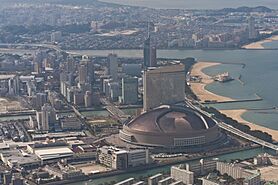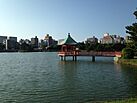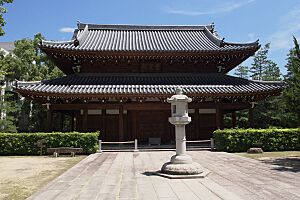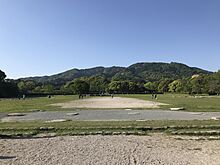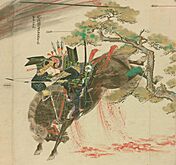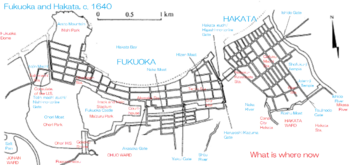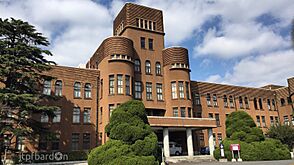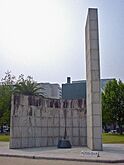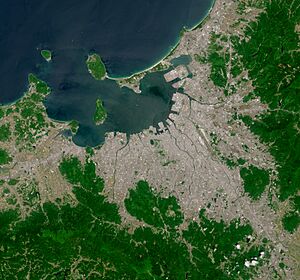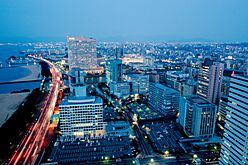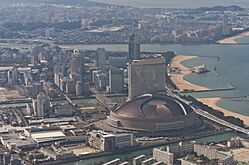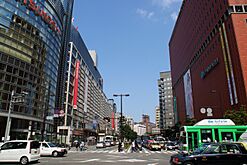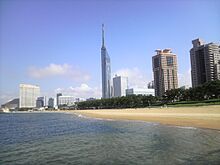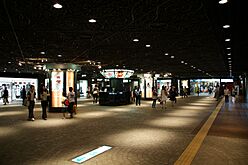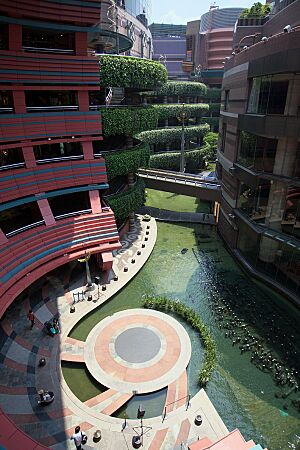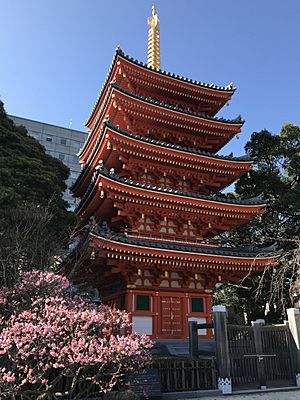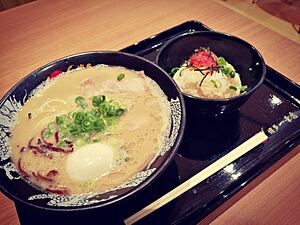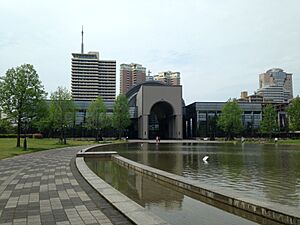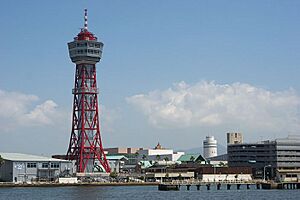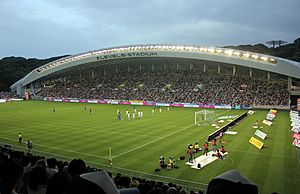Fukuoka facts for kids
Quick facts for kids
Fukuoka
福岡市
|
|||
|---|---|---|---|
| Fukuoka City | |||
|
Clockwise from top:Skyline at Seaside Momochi; Ōhori Park; Marine World Uminonakamichi; Hakata port; Hakata Gion Yamakasa; Hakozaki Shrine; Fukuoka Castle
|
|||
|
|||
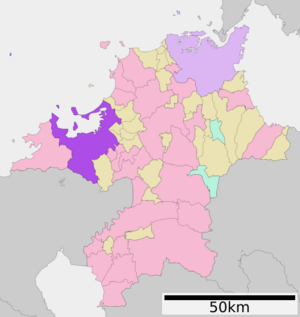
Location of Fukuoka in Fukuoka Prefecture
|
|||
| Country | Japan | ||
| Region | Kyushu | ||
| Prefecture | Fukuoka Prefecture | ||
| First official recorded | 57 AD | ||
| City Settled | April 1, 1889 | ||
| Area | |||
| • Designated city | 343.39 km2 (132.58 sq mi) | ||
| Population
(June 1, 2021)
|
|||
| • Designated city | 1,603,543 | ||
| • Density | 4,669.74/km2 (12,094.58/sq mi) | ||
| • Metro
(2015)
|
2,565,501 (5th) | ||
| Time zone | UTC+9 (Japan Standard Time) | ||
| – Tree | Camphor laurel | ||
| – Flower | Camellia | ||
| – Bird | Black-headed gull | ||
| Fukuoka | |||||
|---|---|---|---|---|---|

"Fukuoka" in kanji
|
|||||
| Japanese name | |||||
| Kanji | 福岡 | ||||
| Hiragana | ふくおか | ||||
| Katakana | フクオカ | ||||
|
|||||
Fukuoka (Japanese: 福岡市, Fukuoka-shi) is one of the largest cities in Japan. It is the capital city of Fukuoka Prefecture. The city is located along the shores of Hakata Bay. It has been an important place for international trade for a very long time.
Fukuoka is the closest major city in Japan to the rest of Asia. Because of this, it has always been a "gateway" to the country. People have lived here since ancient times. Fukuoka has its own special culture and way of speaking, different from other big cities like Kyoto or Tokyo.
Today, Fukuoka is the biggest city on Kyushu island. It is also the largest city and metropolitan area west of the Keihanshin region. In 2015, Fukuoka became Japan's sixth-largest city by population.
Contents
History of Fukuoka
Ancient Times in Fukuoka
People have traded between Fukuoka and mainland Asia since the Old Stone Age. Many early settlers of the Yayoi period came to this area. You can still find ancient burial mounds called Kofun here.
Fukuoka was once known as the Port of Dazaifu. Dazaifu was an important government center in 663 A.D. Some experts believe it might have been an even older capital. Old writings and archaeological finds show that this area was key to Japan's beginnings.
An old guest house for foreign visitors, called the Kōrokan, was found under the ruins of Fukuoka Castle. This shows how important Fukuoka was for meeting people from other countries.
Important Shrines and Temples
Many historical shrines and Buddhist temples are in Fukuoka.
- The Hakozaki Shrine was built in 923.
- Monks who studied in China would return and build temples in Hakata, which is now part of Fukuoka.
- Monk Eisai founded Shōfuku-ji. This is known as Japan's oldest Zen temple. Eisai also brought tea and tea culture to Japan.
- Monk Kukai started Tocho-ji.
- Joten-ji was built by Enni, who also brought Udon noodles from China to Japan.
The famous Hakata Gion Yamakasa festival started in 1241. It began when Enni carried a platform around town. He prayed to stop a plague, and it worked!
Mongol Invasions of Japan
In the late 1200s, Kublai Khan of the Mongol Empire tried to invade Japan. He sent messages asking Japan to accept his rule, but the Japanese leaders refused.
In 1274, Kublai Khan sent a huge fleet of 900 ships and 33,000 soldiers to northern Kyushu. This first invasion failed because of bad planning and strong storms.
After this, Japanese samurai built a stone wall along the coast of Hakata Bay. This wall was 20 kilometers (12 miles) long and 2-3 meters (6-10 feet) high. It was built between 1276 and 1277 to protect against future attacks.
Kublai Khan tried again in 1281 with an even bigger army of 140,000 soldiers and 4,000 ships. The Japanese defenders were outnumbered. However, a powerful typhoon struck, destroying many Mongol ships and stopping the invasion.
This typhoon was called Kamikaze, meaning Divine Wind. This term later became famous during World War II.
How Fukuoka Became a City
Fukuoka used to be the home of powerful lords called daimyō. It played a big role in Japan's history.
The modern city of Fukuoka was formed on April 1, 1889. This happened when two older cities, Hakata and Fukuoka, joined together.
- Hakata was the port and trading area. It was known for its culture and is still the main business area today.
- Fukuoka was where many samurai lived. Its name came from the birthplace of Kuroda Nagamasa, a famous lord. The "old Fukuoka" area is now a main shopping district called Tenjin.
When the two cities merged, they had to pick a new name. After many discussions, Fukuoka was chosen. But the name Hakata is still used for the city's train station, Hakata Station, and its local way of speaking, Hakata-ben.
Fukuoka in Recent Times
Many important things happened in Fukuoka during the 20th and 21st centuries.
- 1903: Fukuoka Medical College was founded. It later became Kyushu University in 1911.
- 1910: Streetcar service began in the city.
- 1945: Fukuoka was bombed during World War II. About 21.5% of the city was destroyed.
- 1951: Fukuoka Airport opened.
- 1975: The high-speed San'yō Shinkansen train line reached Hakata station.
- 1981: The city's subway system started running.
- 11988: A professional baseball team, the Nankai Hawks, moved to Fukuoka. They are now the Fukuoka SoftBank Hawks.
- 2005: The Fukuoka subway Nanakuma Line began operations.
- 2014: Fukuoka was chosen by the Japanese government as a special zone for "global startups and job creation." This means it's a great place for new businesses to start.
Geography of Fukuoka
Fukuoka is surrounded by mountains on three sides. It sits around Hakata Bay and opens to the Genkai Sea in the north. It is about 1,100 kilometers (680 miles) from Tokyo.
The closest big city overseas is Busan in South Korea. Busan is only about 180 kilometers (112 miles) away. Fukuoka and Busan are sister cities, meaning they have a special friendly relationship.
Fukuoka's Climate
Fukuoka has a humid subtropical climate. This means it has hot and humid summers. Winters are usually mild. The city gets about 1,600 millimeters (63 inches) of rain each year. Most of the rain falls between June and September.
Winter temperatures rarely drop below 0°C (32°F). Snow is not common, but light snow can fall on some days. Spring is warm and sunny, with cherry blossoms blooming in late March or early April.
The rainy season lasts about six weeks in June and July. During this time, it is very humid, and temperatures are between 25°C (77°F) and 30°C (86°F). Summers are hot and humid, sometimes reaching 37°C (99°F). Autumn is often considered the best season. It is mild and dry, but typhoons can happen between August and September.
Earthquakes in Fukuoka
Fukuoka does not have as many earthquakes as some other parts of Japan. However, it does experience them sometimes.
On March 20, 2005, a strong earthquake hit Fukuoka. It caused some damage and injuries. The earthquake's center was in the Genkai Sea. Aftershocks continued for several weeks. Old Japanese houses were the most damaged.
Experts believe a fault line called the Kego fault runs under Fukuoka. It is thought to be about 40 kilometers (25 miles) long. Scientists study this fault to understand earthquake risks.
Wards of Fukuoka
Fukuoka is divided into 7 main areas called wards (ku). Each ward has its own unique features.
| Wards of Fukuoka | |||||||
|---|---|---|---|---|---|---|---|
| Place Name | Map of Fukuoka | ||||||
| Rōmaji | Kanji | Color | Population | Land area in km2 | Pop. density
per km2 |
||
| 1 | Higashi-ku | 東区 | 291 749 | 66.68 | 4 375.36 | ||
| 2 | Hakata-ku | 博多区 | 212 108 | 31.47 | 6 740.01 | ||
| 3 | Chūō-ku (administrative center) |
中央区 | 176 739 | 15.16 | 11,658.24 | ||
| 4 | Minami-ku | 南区 | 248 901 | 30.98 | 8 034.25 | ||
| 5 | Jōnan-ku | 城南区 | 128 883 | 16.02 | 8 045.13 | ||
| 6 | Sawara-ku | 早良区 | 211 889 | 95.88 | 2 209.42 | ||
| 7 | Nishi-ku | 西区 | 190 288 | 83.81 | 2 270.47 | ||
City Views and Landmarks
Fukuoka has a beautiful skyline and many interesting places.
People and Economy
Population of Fukuoka
Fukuoka is Japan's youngest major city. Its population is growing faster than any other big city in Japan. This includes more people moving in from other countries.
As of March 2023, Fukuoka had a population of over 1.6 million people.
Fukuoka's Economy
Fukuoka is the main economic hub of the Kyushu region. Its economy mostly focuses on services. It is also known as Japan's biggest city for "startups." Startups are new businesses that are just beginning.
Fukuoka offers many services to help new businesses. These include special visas and tax benefits. Fukuoka has the highest rate of new business openings in Japan.
Big companies like Iwataya and Kyushu Electric Power are based here. Fukuoka also has many smaller companies that help with shipping, technology, and high-tech manufacturing. Most heavy manufacturing happens in nearby Kitakyushu.
The port of Hakata and Fukuoka Airport are important for transportation. They make Fukuoka a key center for travel and trade in the region.
Fukuoka also has its own stock exchange, which started in 1949. It is one of only six in Japan. Fukuoka is known as one of the most affordable cities in Japan to live in.
Culture and Fun in Fukuoka
Fukuoka has a lively culture and many fun things to see and do. Newsweek magazine once called it one of the "Most Dynamic Cities." This is because of its location, growing tourism, and trade.
Monocle magazine also listed Fukuoka as one of the "Top 25 liveable cities." They praised its shopping, food, transport, museums, green spaces, and friendly atmosphere.
The ACROS (Asian Cross Road Over the Sea) building is a cultural center. It has the Fukuoka Symphony Hall and hosts many cultural events. It is also famous for its unique green design.
Tourism and Attractions
Fukuoka welcomes over 2 million foreign visitors every year. Most come from nearby South Korea, Taiwan, and China. Many cruise ships also visit Hakata Port.
Nearly 10,000 international students study at universities in or near Fukuoka. The city also hosts almost 200 international conferences each year.
Places to Visit
- Fukuoka Castle is in Maizuru Park. You can see its old stone walls and parts of the castle that have been rebuilt.
- Ōhori Park is a beautiful park with a large pond. It is also home to one of Fukuoka City's main art galleries.
- Many old temples like Tōchō-ji, Hakozaki Shrine, and Jōten-ji are worth visiting.
- The Buddhist Nanzoin temple has a very large statue of a reclining Buddha.
- Marinoa City Fukuoka is a shopping center. It used to have a big Ferris wheel called Sky Dream Fukuoka.
- Marine Park Uminonakamichi is on a narrow piece of land by Hakata Bay. It has an amusement park, a petting zoo, gardens, beaches, and a large aquarium.
- When you visit, try local foods like mentaiko (spicy fish roe), Hakata ramen (a type of noodle soup), and motsunabe (a hot pot dish). You can find yatai (street food stalls) selling ramen in Tenjin and Nakasu in the evenings.
- Fukuoka Tower is a tall tower near the beach in Seaside Momochi. You can go up for great views.
- Hakata Port Tower is an older symbol of the city. It is next to the international ferry terminal and is free to enter.
- Itoshima, west of Fukuoka, is a popular spot. It has many beaches and the beautiful Raizan Sennyoji temple.
Museums to Explore
- Fukuoka Art Museum in Ohori Park has modern art from around the world.
- Fukuoka Asian Art Museum displays art from different Asian countries.
- Fukuoka City Museum shows items from the region's history, including a famous gold seal.
- Genko Historical Museum in Higashi Koen shows Japanese and Mongolian armor from the 13th century. It also has paintings about historical events.
- Hakata Machiya Folk Museum teaches about the traditional ways of life and culture in Fukuoka.
- The Kyushu National Museum is in nearby Dazaifu.
Exciting Festivals
Fukuoka has many exciting festivals (matsuri) throughout the year. The most famous are Hakata Dontaku and Hakata Gion Yamakasa.
Hakata Gion Yamakasa
The Yamakasa festival is held for two weeks every July. It is Fukuoka's oldest festival, with a history of over 700 years. It started in 1241 when a priest was carried around the city to stop a plague.
Teams of men carry huge floats weighing thousands of pounds. They race around a course to remember the priest's journey. Only men are allowed to carry the floats. Participants wear special traditional loincloths called shimekomi.
The festival has many events and practice runs. It ends with a big race early in the morning on the last day. Thousands of people line the streets to cheer. During the festival, you will see men wearing special happi coats with their team's symbol.
Hakata Dontaku
The Hakata Dontaku festival takes place on May 3 and 4. It has a history of over 800 years. More than 2 million people attend, making it the most popular festival during Japan's Golden Week holidays.
During the festival, stages are set up downtown for traditional performances. There is also a parade of colorful floats. The full name of the festival is Hakata Dontaku Minato Matsuri.
Music Scene
Fukuoka is home to many famous musicians.
- Well-known J-pop artists like Ayumi Hamasaki, Chage & Aska, Misia, and Yui are from Fukuoka.
- The J-pop group Morning Musume has had members from Fukuoka, including Reina Tanaka and Erina Ikuta.
- The K-pop group Kep1er member Ezaki Hikaru was born in Fukuoka.
- The city also has its own idol group, HKT 48, with their own theater.
Getting Around Fukuoka
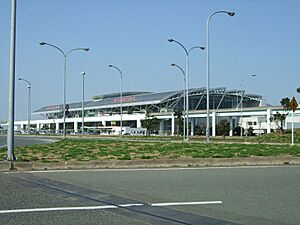
Fukuoka has many ways to get around.
- Air: Fukuoka Airport serves the city.
- Train: The San'yō Shinkansen and Kyushu Shinkansen high-speed rail lines stop at Hakata Station. Other JR Kyushu trains also use this station.
- Ferry: Ferries run between Hakata and Busan, South Korea.
- Subway: Fukuoka has three subway lines: the Kūkō Line, the Hakozaki Line, and the Nanakuma Line.
- Private Railway: The Nishitetsu private railway connects the downtown area of Tenjin to the city of Ōmuta.
Sports in Fukuoka
Fukuoka is a big sports city. It is home to the Fukuoka SoftBank Hawks, one of Japan's best professional baseball teams. Their home stadium is the Fukuoka PayPay Dome.
The city also has a professional football (soccer) team, Avispa Fukuoka.
Annual Sporting Events
- The All Japan Judo Category Championships are held in early April.
- The November tournament for professional Sumo wrestling takes place at the Fukuoka Kokusai Center.
Major Sporting Events Hosted
Fukuoka has hosted many big sports events, including:
- The Fukuoka Marathon (from 1947 to 2021).
- The 1995 Summer Universiade (a multi-sport event for university athletes).
- The 2001 World Aquatics Championships.
- The 2023 World Aquatics Championships.
Sports Teams and Facilities
| Club | Sports | League | Venue | Established |
|---|---|---|---|---|
| Kyuden Voltex | Rugby | Top League | Level-5 Stadium | 1951 |
| Coca-Cola Red Sparks | Rugby | Top League | Sawayaka Sports Park | 1966 |
| Fukuoka SoftBank Hawks | Baseball | Pacific League | Fukuoka PayPay Dome | 1989 (moved from Ōsaka) |
| Avispa Fukuoka | Association football | J. League | Level-5 Stadium | 1995 (moved from Fujieda, Shizuoka) |
| Fukuoka J-Anclas | Association football | Nadeshiko League | Level-5 Stadium | 1986 |
| Rizing Zephyr Fukuoka | Basketball | B.League | Accion Fukuoka | 2007 |
| Fukuoka Suns | American Football | X-League | Hakata-ku, Fukuoka | 2017 |
Education in Fukuoka
Fukuoka City manages all public elementary and junior high schools. The prefecture manages the high schools.
Universities and Colleges
- National universities: Kyushu University
- Prefectural university: Fukuoka Women's University
- Private universities: Fukuoka University, Seinan Gakuin University, and others.
Fukuoka's International Connections
Fukuoka has ten sister cities around the world. These are cities with special friendly ties.
 Oakland, United States (since 1962)
Oakland, United States (since 1962) Guangzhou, China (since 1979)
Guangzhou, China (since 1979) Bordeaux, France (since 1982)
Bordeaux, France (since 1982) Naples, Italy (since 1983)
Naples, Italy (since 1983) Auckland, New Zealand (since 1986)
Auckland, New Zealand (since 1986) Ipoh, Malaysia (since 1989)
Ipoh, Malaysia (since 1989) Qingdao, China (since 2003)
Qingdao, China (since 2003) Atlanta, United States (since 2005)
Atlanta, United States (since 2005) Busan, South Korea (since 2007)
Busan, South Korea (since 2007) Delhi, India (friendship city since 2007)
Delhi, India (friendship city since 2007) Yangon, Myanmar (since 2016)
Yangon, Myanmar (since 2016)
Fukuoka also started the Asian Pacific City Summit in 1994. This group includes 26 cities from the Asia-Pacific region. The Asian Pacific Children's Convention was also started in Fukuoka in 1988.
Famous People from Fukuoka
- Jirō Akagawa, novelist
- Aska (singer) (Chage and Aska)
- Sonny Chiba, actor and martial artist
- Ayumi Hamasaki, best-selling solo artist
- Kanna Hashimoto, actress and singer
- Kiyoshi Hikawa, enka singer
- Kōki Hirota, former Prime Minister of Japan
- HKT48, idol group
- Erina Ikuta, J-pop singer
- Mio Imada, actress and model
- Sui Ishida, manga artist
- Misia, J-pop singer
- Kento Miyahara, professional wrestler
- Ryutaro Nakahara, DJ and musician
- Katsuhiko Nakajima, professional wrestler
- Noriko Sakai, singer and actress
- Kensuke Sasaki, professional wrestler
- Ringo Shiina, J-pop singer
- Keita Tachibana, J-pop singer
- Takehiro Tomiyasu, footballer
- Kane Tanaka, one of the oldest people ever
- Reina Tanaka, J-pop singer
- Ryoko Tani, judo athlete
- Kohei Uchimura, artistic gymnast
- Yui, singer
- Haruto Watanabe, K-pop Idol
See also
 In Spanish: Fukuoka para niños
In Spanish: Fukuoka para niños


